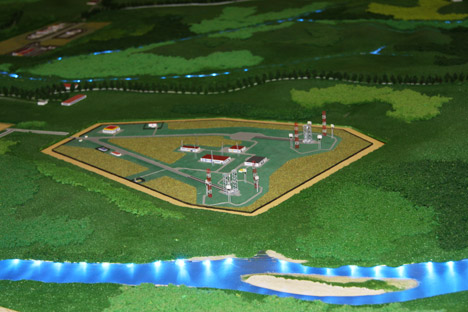Russia builds an eastern route to the stars

The project of the new base Vostochny. Source: Svetlana Mikhailova / RIA Novosti.
“I am delighted with the pace of construction. If we can keep going at this rate, then we can expect the first launch of spacecraft from here in 2015,” said the Roscosmos chief of construction.
“Construction of facilities at Vostochny is now going on around-the-clock, involving two-and-a-half million workers and more than 600 pieces of equipment. Budgetary injection is planned at the level of 20 billion rubles this year ($630.9 million), and 10 billion rubles higher in 2013,” the construction chief said.
The principle objective in building the Vostochny base was outlined by President Vladimir Putin in a speech he made during his visit to the Russian cosmodrome: “Our goal is for Russia to get a national space center that meets the most demanding international standards and requirements.”
“It follows that the strategic objective is ensuring the self-sufficiency of space activities over the entire range of applications – from socio-economic and scientific launches, through to manned space flight. It's initially planned to lessen operations at the Baikonur cosmodrome, without replacing it entirely – at least, not until the expiry of the lease agreement with Kazakhstan,” said Putin.
From the technical side of things, the bosses at Roscosmos believe the Vostochny base offers significant advantages: the initial launch trajectory would not pass over heavily populated areas or the territory of foreign countries; the zones in which the detachable thrust sections of the booster rockets would fall lie in international waters or areas of low population density in Russia; and the cosmodrome's location has excellent access to existing road, rail and airport infrastructure.
However, when considering the economic side of the equation, the new space center will be twice as expensive as Baikonur. According to the director of the Spetstroy Federal Construction Agency (the company legally responsible for the site’s construction), Grigory Naginsky, the cost of building the Vostochny Cosmodrome is approaching 300 billion rubles, which approaches the cost involved for the Russian Winter Olympics in Sochi or the APEC Summit in Vladivostok.
Meanwhile Russia and Kazakhstan have a long-standing agreement about Russia's lease of the Baikonur space center until 2050. Russia makes an annual payment to its neighboring country of $115 million dollars – a lease payment which is fixed for the entire duration of the lease. This means that the cost of leasing Baikonur for the remaining 38 years of the lease agreement will total $4.4 billion.
There are geographic issues, as well. Initially, experts were leaning toward the Primorsky Region port of Nakhodka, which is one of Russia's southernmost points and positioned three degrees south of Baikonur. On top of this, Nakhodka is a sea port – making sea transportation available for unwieldy spacecraft, and offering extensive economic savings over the delivery of spacecraft by air from the factories that build them.
Experts calculated these same kinds of savings in Beijing, when they completed construction of their fourth space center at the coastal location of Wenchang.
Nevertheless, the site in Amur Region won the bid. The launch-pad will be nine degrees north of the Nakhodka location, and six degrees north of Baikonur. The location will result in reduced payload weights for space launches.
The political backdrop played a significant role in deciding between the different regional options on the table. To begin with, launches from Nakhodka could have possibly crossed into Japanese airspace. If a malfunction were to occur in the initial launch phase, fragments of the craft – possibly highly toxic – could fall within the territory of a neighboring country such as Japan. Furthermore, safety reasons ruled out another possible location for the space center site – in the vicinity of Sovietskaya Gavan in Khabarovsk Region. This location would have been even closer to Japan than Nakhodka.
Overall, the choice of Vostochny reflects the relentless rise in the costs of transporting space hardware. The main space industry producers in Russia are located in Moscow, Samara, and Zheleznogorsk (Krasnoyarsk Region, Siberia). Space vehicles, rocket launch vehicles and staff have to be transported from there to Baikonur, by air or by rail transport, over a distance between 930 and 1550 miles. When the new facility at Vostochny opens, this distance will increase to 3,420 miles.
The range of local temperatures also impacts the costs involved in the construction work – from 95 degrees Fahrenheit, down -40 degrees Fahrenheit. For example, consider the costs of building foundations in the frozen soil alone.
The take-off trajectories are such that, should a malfunction occur, the escape capsule would most likely touch down in the sea. Getting to the capsule would be difficult, and Russia has traditionally worked only with land-based rescue systems.
Despite all this, the Vostochny Cosmodrome is now an objective Russian reality. It could be that Deputy Prime Minister Rogozin was right when he spoke in April about the macro-economic significance of the new space center. As Rogozin pointed out, the Russian Far East borders some of the world's most heavily populated nations. “The Vostochny Cosmodrome will play a role in creating an equilibrium of population density in Russia,” said Rogozin.
All rights reserved by Rossiyskaya Gazeta.
Subscribe
to our newsletter!
Get the week's best stories straight to your inbox